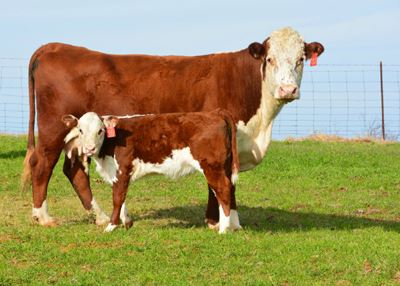|
Short Supplies, High Demand Boost Cattle Producer Profits
MISSISSIPPI STATE, MISS.
Mississippi’s beef cattle producers just experienced the best year in history, and 2015 looks equally promising.
Mississippi State University Extension Service agricultural economist John Michael Riley said droughts in cattle-producing states, especially in 2012, resulted in tighter supplies, while consumer demand for beef has remained strong.
“Each producer has one question to ask before buying an additional cow to expand a herd,” Riley said. “Will she pay for herself in the coming years? The answer will depend on the availability of land and forages, additional labor needs and equipment costs.”
Riley estimated the 2014 value of Mississippi’s cattle industry at $397 million, up 33 percent from the previous year. Cattle and calves are the state’s fifth largest agricultural commodity behind poultry, forestry, soybeans and cotton.

Beef cattle, such as these Herefords in Oktibbeha County, are part of Mississippi’s fifth most valuable agricultural commodity in the state for 2014. This mother and calf are part of the Mississippi State University herd on the Henry H. Leveck Research Farm
on the south side of the MSU campus on Dec. 17, 2014.
Photo by MSU Ag Communications/Linda Breazeale
“The economy continues to improve, which supports higher beef prices at the grocery store,” Riley said. “We know retail and restaurant prices will eventually reach a ceiling for consumers, but farm-level cattle prices should not change directions very quickly when that happens.”
Riley said Mississippi’s lightweight calf prices have averaged around $2.50 per pound in 2014. Heavyweight feeder cattle were closer to $1.80 per pound. By comparison, lighter calves were $1.50 per pound in 2013, and the heavier cattle were around $1.25 per pound.
Riley said low prices occurred in 2009 when lightweight cattle were around $1 per pound and heavyweights were around 85-90 cents per pound. Prices started rising even before major cattle-producing states began to experience droughts about three years ago.
Another positive for the industry – and it is a big one – is the lower cost of corn and soybeans, the two major ingredients in cattle feed.
“The droughts that caused producers to reduce their herd sizes also reduced national crop yields and drove up feed costs. Now, we’ve had a couple growing seasons that were much better, contributing to better feed supplies and lower costs,” Riley said.
Brandi Karisch, an MSU Extension beef specialist, said Mississippi’s cow/calf operations have had plenty of forage in recent years.
“States with typically large numbers of cattle have reduced their herd sizes because of the lack of forages,” she said. “Now, feedlots can’t get enough cattle. Most of our cattle are sold to feedlots that finish feeding them out with grains, which are less expensive than in recent years.”
Karisch said at the beginning of 2014, Mississippi had 18,000 beef cattle operations with 477,000 cattle.
“Cattle are valuable, so producers are taking good care of them and trying to improve genetics,” she said.
Sammy Blossom, executive vice president of the Mississippi Cattlemen’s Association, said bull sales have set record prices in the past year.
“Demand for top-quality bulls has grown in recent years, which is evidence our producers are improving genetics,” he said. “Producers see the difference in growing good calves and growing ordinary calves.”
Additionally, cattle producers are working hard to make their land as productive as possible, he said. They are adding more fertilizer or leasing more land to expand forage capacity.
“Most of our producers rely on forages, not grains, to produce calves to send to feedlots in the Midwest,” Blossom said. “The quality of our calves appeals to the feedlots, and they are willing to pay a premium.”
Blossom said the long-range forecast for cattle remains strong.
“Medium to large operations are expanding some. They are retaining heifers if there is no large capital investment necessary,” he said. “Better managed herds will see long-term benefits.” ∆
|
|